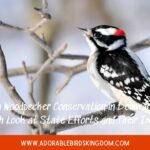I’ve always been fascinated by the impressive diversity of wildlife in Nebraska, and hawks are no exception. These majestic birds of prey are a sight to behold, soaring high above the plains and forests. They’re a crucial part of Nebraska’s ecosystem, playing a vital role in maintaining balance among wildlife populations.
In Nebraska, you’ll find several species of hawks, each with its unique traits and behaviors. From the broad-winged hawk to the sharp-shinned hawk, these raptors are truly captivating. Whether you’re a bird watcher, a nature enthusiast, or just curious, getting to know Nebraska’s hawks is a rewarding experience.
Stay tuned as we dive deeper into the world of these fascinating creatures, exploring their habits, habitats, and the challenges they face in the modern world. It’s a journey that’ll give you a whole new perspective on Nebraska’s wildlife.
Overview of Hawks in Nebraska
When you think of Nebraska’s wildlife, it’s hard not to picture the stunning hawks soaring above the rolling plains. Their awe-inspiring strength and beauty have become an emblem of the state. There are six native hawk species in Nebraska, each with their unique characteristics and roles within the state’s ecosystem.
The Red-tailed Hawk, often known as the “chickenhawk,” is the most prevalent species in Nebraska and across North America. Even if you’re not a bird enthusiast, chances are you’ve spotted one of these magnificent birds. They’re known for their broad, rounded wings and short, wide tails, which are brick-red above in mature birds.
Swaggering in next is the Cooper’s Hawk. It’s agile and lightning-fast, a silent predator renowned for feeding on other birds. Their preference for woodland areas and their distinctive flight pattern sets them apart.
The Ferruginous Hawk, the Swainson’s Hawk, the Rough-legged Hawk, and the Northern Harrier are the other hawk species that grace Nebraska’s skies. Each of these species has distinctive traits that make them stand out, yet they all contribute to maintaining balance in Nebraska’s diverse ecosystem.
A variety of factors including habitat type, availability of food, mating habits, and season dictate the distribution of these hawk species across the state. Take note, bird watchers and wildlife enthusiasts,rhooked beak and piercing eyes of a hawk are a sight to behold, their silent flight a testament to the marvels of nature.
Here’s a table spotlighting Nebraska’s hawk species and their key distinguishing features:
| Hawk Species | Distinguishing Features |
|---|---|
| Red-tailed Hawk | Broad, rounded wings; short, wide tails |
| Cooper’s Hawk | Agile, quick; prefers woodland areas |
| Ferruginous Hawk | Rusty legs and large size |
| Swainson’s Hawk | Long, pointed wings; white underparts |
| Rough-legged Hawk | Feathered legs to the toes; white tail with band at the tip |
| Northern Harrier | Unique face shape; low flight pattern over open fields |
From their unique behaviors and adaptations, it’s evident that hawks are indispensable components of Nebraska’s wildlife – fascinating creatures that intertwine us with the rhythms of the natural world.
Importance of Hawks in the Ecosystem
Hawks play a vital role in Nebraska’s ecosystem, serving as nature’s very own pest control. Their predatory habits keep the population of rodents and insects in check, maintaining a healthy balance in the local environment.
In particular, the Red-tailed Hawk and Cooper’s Hawk are well-known for their relentless pursuit of mice, rats, and squirrels. On the other hand, Ferruginous Hawks and Swainson’s Hawks prefer hunting insects such as grasshoppers and beetles, contributing to the control of these potentially destructive arthropods.
When it comes to the Rough-legged Hawk and the Northern Harrier, these species often feed on both rodents and insects. By doing this, they tackle both major groups of pests, helping keep the ecosystem balanced.
The impact of these Nebraska native hawks is also felt on a wider scale. Hawks’, as a species, contribution to the ecosystem is in terms of:
- Pest Control
- Scavenging
- Seed dispersal
Their diet isn’t limited to just pests. Occasionally, they are scavengers and consume carrion, contributing towards the cleanup of the ecosystem.
Furthermore, the undigested portion of their prey, which contains seeds, get expelled in their droppings, aiding in seed dispersal. This helps in the propagation of several plant species, indirectly supporting herbivores.
Hawks exist at the top of the food chain and indicate the health of the overall ecosystem. A stable hawk population signifies a balanced ecosystem, while a declining hawk population could hint at potential underlying environmental issues.
Without these majestic raptors, Nebraska’s ecosystem would run the risk of becoming overrun by pests and would lack the natural cleanup and seed dispersal that they provide. As we delve further into understanding the roles and responsibilities of these hawks, we see just how interconnected our natural world is.
Diversity of Hawk Species in Nebraska
Nebraska’s rich biodiversity is home to a varied range of raptor species, notably different types of hawks. Let’s delve deeper into these winged marvels that are intrinsic to Nebraska’s thriving ecosystem.
Red-Tailed Hawk
First on the list is the Red-tailed Hawk. Undeniably the most common, you’ll find it spread throughout the state. It’s a large, robust bird recognized by a broad, rounded wingspan and striking red tail. These hawks are keen hunters, feeding primarily on small rodents, such as mice and voles.
Cooper’s Hawk
The Cooper’s Hawk, another native species, is smaller and has a longer tail compared with the Red-tailed Hawk. Its hunting technique is fascinating, swiftly darting through forests to catch smaller birds, thus preventing an overpopulation of certain bird species.
Ferruginous Hawk
One of the bigger species, the Ferruginous Hawk, prefers open plains and grasslands which are abundant in Nebraska. This imposing predator can be identified by its light-colored plumage and dark, rust-colored wings. It notably feeds on a diet of large insects and mammals.
Swainson’s Hawk, Rough-Legged Hawk, and Northern Harrier
Other notable mentions include Swainson’s Hawk, Rough-legged Hawk, and the Northern Harrier. Each contributes in its unique way to Nebraska’s balanced ecosystem. Swainson’s Hawk is known for its long-distance migratory patterns, the Rough-legged Hawk storms in during winter months, and the Northern Harrier, a ground-hunting hawk, is famous for its owl-like face.
The varied profile of these hawk species speaks volumes about theamply diverse ecosystem of Nebraska. Each species, with its unique hunting patterns, diet, and migration patterns, plays a crucial role in maintaining the health and balance of our natural world. This further underscores the importance of preserving these majestic creatures, their habitats, and in turn, maintaining the intricate balance of life in Nebraska.
Behaviors and Traits of Nebraska Hawks
As we continue our exploration of Nebraska’s hawk species, it’s time we delve into their distinguishing behaviors and traits. Each species possesses distinct characteristics and hunting techniques that not only make them unique but also crucial to maintaining the balance of the ecosystem.
Let’s start with the Red-tailed Hawk, the most common hawk in North America. It’s known for its broad, rounded wings and a short, wide tail. This species often uses elevated perches to scout for prey, swooping down with great speed when a potential meal is in sight.
Moving on, the Cooper’s Hawk is an agile flier that often chases its prey through the woods with daring acrobatics. It’s smaller in size compared to the Red-tailed Hawk and has a leaner silhouette, marking its adaptation for life in densely wooded areas.
Unique to the plains and largely associated with grasslands, the Ferruginous Hawk is renowned for its size. It’s one of the largest hawks you’ll find in Nebraska. It has broad wings and shows a preference for ground squirrels and rabbits.
Further, the Swainson’s Hawk, a long-distance migrant, is remarkable for its aerial hunting techniques. During its stay in Nebraska, it feeds mainly on insects and small mammals, contributing to pest control in the region.
The Rough-legged Hawk and Northern Harrier, on the other hand, share a unique trait not common among other hawk species – they nest on the ground. Distinct due to their hovering behavior before diving for prey, they’re a sight to behold in the Nebraska skies.
Diving in a little deeper into their behaviors, it’s important to understand their hunting patterns, diets, and nesting habits. A deep-dive perspective can aid conservation efforts by providing insights into the needs of these raptors. As we continue to learn about their role in Nebraska’s ecosystem, it’s evident that these hawks are more than just predators; they’re essential parts of a delicate environmental balance.
Conservation Efforts and Challenges
Nebraska is home to a dazzling array of hawks, each showcasing unique hunting tactics, diets, and nesting behaviors. These raptors, sitting at the top of their food chains, play a critical role in maintaining the delicate ecological balance. However, it’s worth noting that these magnificent birds face numerous threats, highlighting an urgent need for conservation efforts.
Habitat loss is perhaps the most prominent challenge facing hawks in Nebraska. The constant expansion of human settlements, coupled with agricultural intensification, is dramatically reducing the natural habitats of these raptors. This encroachment not only decreases their territory but also limits their access to prey, thereby affecting their survival.
Equally worrying is the increasing use of rodenticides. Often consumed by the small mammals that hawks prey on, these deadly toxins build up in the hawks’ systems, resulting in severe illness and oftentimes death. Thus, the use of rodenticides indirectly poses a serious threat to these raptors’ populations.
To safeguard Nebraska’s hawks, there are several ongoing conservation initiatives. Non-profit organizations, wildlife agencies, and local communities are putting significant efforts into preserving and restoring these magnificent birds’ habitats. These restoration projects include planting native grasses, shrubs and trees, creating nesting sites and protecting existing ones.
Another approach to hawk conservation lies in spreading awareness and education about these formidable predators. Guided tours, bird watching events, and awareness campaigns serve to enlighten the public about the important role hawks play in the environment. Encouraging a respect and appreciation for these birds can help foster a commitment to their preservation among locals.
It’s clear that the conservation of these raptors involves overcoming considerable challenges. Still, with committed efforts and continued education, a safer future for Nebraska’s hawks could be on the horizon. And while I have delved into some of these issues, there are many more aspects of hawk conservation to explore.
Conclusion
I’ve seen firsthand the impact of conservation efforts on Nebraska’s hawks. It’s no small feat dealing with habitat loss and the indirect effects of rodenticides. Yet, the resilience of these raptors is truly remarkable. The work being done to restore habitats and create nesting sites is making a difference. It’s not just about providing a safe haven for hawks but also about maintaining the balance in our ecosystem. I believe that through continued efforts and increased public awareness, we can ensure a thriving future for these iconic predators. After all, the hawks of Nebraska are more than just birds – they’re a vital part of our state’s rich biodiversity.



